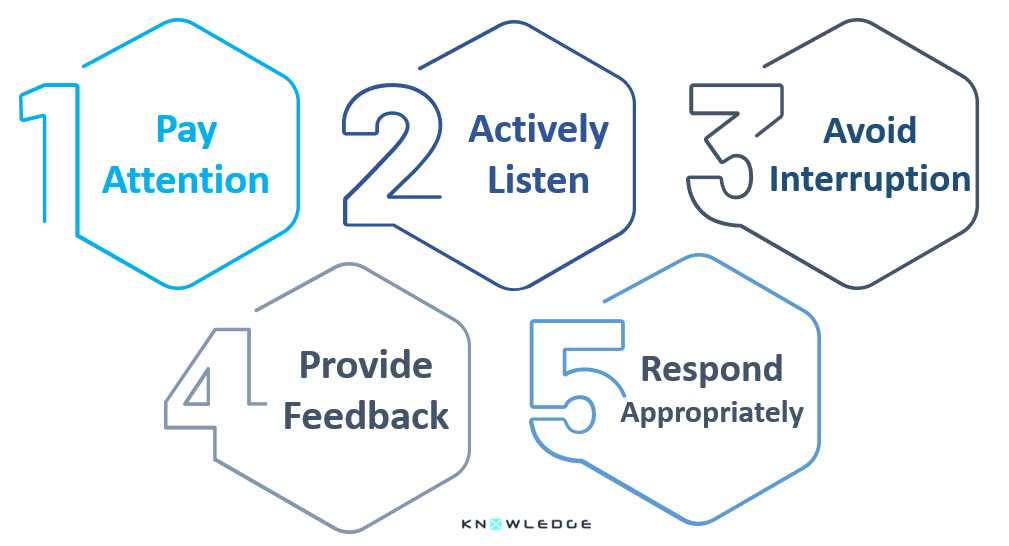According to the definition of the business dictionary, “Active listening is the act of mindfully hearing and attempting to comprehend the meaning of words spoken by the other party in the conversation or speech”. This involves responding to the speaker by relaying their thoughts without agreeing or disagreeing and without adding your thoughts, interpretations, feelings, experiences or ideas.
Listening is considered one of the most important skills a human being poses. How well you listen has a major impact on your capability of acquiring knowledge, job effectiveness, in addition to the quality of your relationships with others. Most of the learning and development that we went through in our life wouldn’t have happened if it was not for listening skill. To keep it short and simple, we listen for variant reasons; obtain information, understand and learn.
Listening is one of the skills that worth improving. By becoming a better listener, you will improve your productivity, your ability to influence, persuade and negotiate. What's more, it can help you avoid conflict and misunderstandings.
Given all this listening we do, you would think we'd be good at it by default! The fact is most of us are not. Depending on the study being quoted, we remember between 25% and 50% of what we hear. That means that when you are listening to your seniors, colleagues, customers or spouse for 10 minutes, you pay attention to less than half of the conversation. This is dismal!
It reveals that when you are receiving directions or being presented with information, you aren't hearing the whole message, you hope the important parts are captured in your 25-50%, but what if they're not?
The way to become a better listener is to practice "active listening". This is where you make a conscious effort to hear not only the words that another person is saying but, more importantly, try to understand the complete message being sent. As an active listener, you should then be able to repeat back in your own words the whole message. This doesn’t mean you agree with, but rather understand what is said.
There are five key elements for active listening:
- Pay attention (avoid distractions)
- Actively listen (show that you are listening)
- Avoid interruption
- Provide feedback
- Respond Appropriately

1. Pay Attention (avoid distractions)
You need to provide the speaker with your undivided attention and acknowledge the message. recognise the non-verbal communication, this can be achieved by:
§ Maintaining eye contact with the speaker.
§ Avoiding interruptions – put aside distracting thoughts, avoid mentally preparing to respond or thinking of a solution.
§ Avoiding getting distracted by the surrounding environment, try to always move to a quiet location.
§ Focusing on the individual speaking and refrain from carrying out other activities.
2. Actively listen
§ “Listen” and observe the speaker’s body language as that shows a lot about their status.
§ Nod occasionally, this indicates to the speaker that you are giving them your undivided attention.
§ Use appropriate facial expressions as needed.
§ Make sure your posture and body language is open and inviting.
§ Encourage the speaker to continue the conversation using short comments like “yes”, “and” and “uh”.
3. Avoid Interruption
Interruption one of the worst blockers of active listening, it can frustrate the speaker and limits the full understanding of the message. When listening you should:
§ Allow the speaker to finish the whole message.
§ Don’t interrupt with counter-arguments.
§ Avoid excusing from the conversation to do other tasks or take a call, give full attention.
4. Provide feedback
While listening, avoid assumptions, judgments and creating your own beliefs. This tends to distort what we hear and can lead to a change of understanding. This is often referred to as creating personal filters.
As an active listener, your main role is to comprehend and understand what is being said, reflect the message, probe and ask more relevant questions.
The following steps could help you while providing feedback:
§ Relay back your understanding of what is being said by paraphrasing. You can get into this habit by getting used to starting your sentences with “what I hear / Understand is …” and “sounds like you are saying …”.
§ Ask open-ended questions to clarify some points using questions like “what do you mean when you say …” and worth ending with clarifying using a statement like “Is that what you mean?”.
§ Summarise the speaker’s conversation periodically to ensure that you are getting the right message.
5. Respond Appropriately
As a listener, you should be able to repeat back in your own words the whole message. This doesn’t mean you agree with the listener, but it rather confirms that you understand what they are saying. Active listening is a model of respect and understanding, you should not attack the speaker, or play down, so:
§ Be open and empathetic in your response.
§ Assert your opinions respectfully using assertiveness “I statement” or “ASI Technique”.
§ Treat the other person as you want to be treated in a similar situation.
Developing active listening is a learning process. It requires putting it in conscious practice and giving the time to acquire such advanced skill.



Comments
No Comments added, be the first...